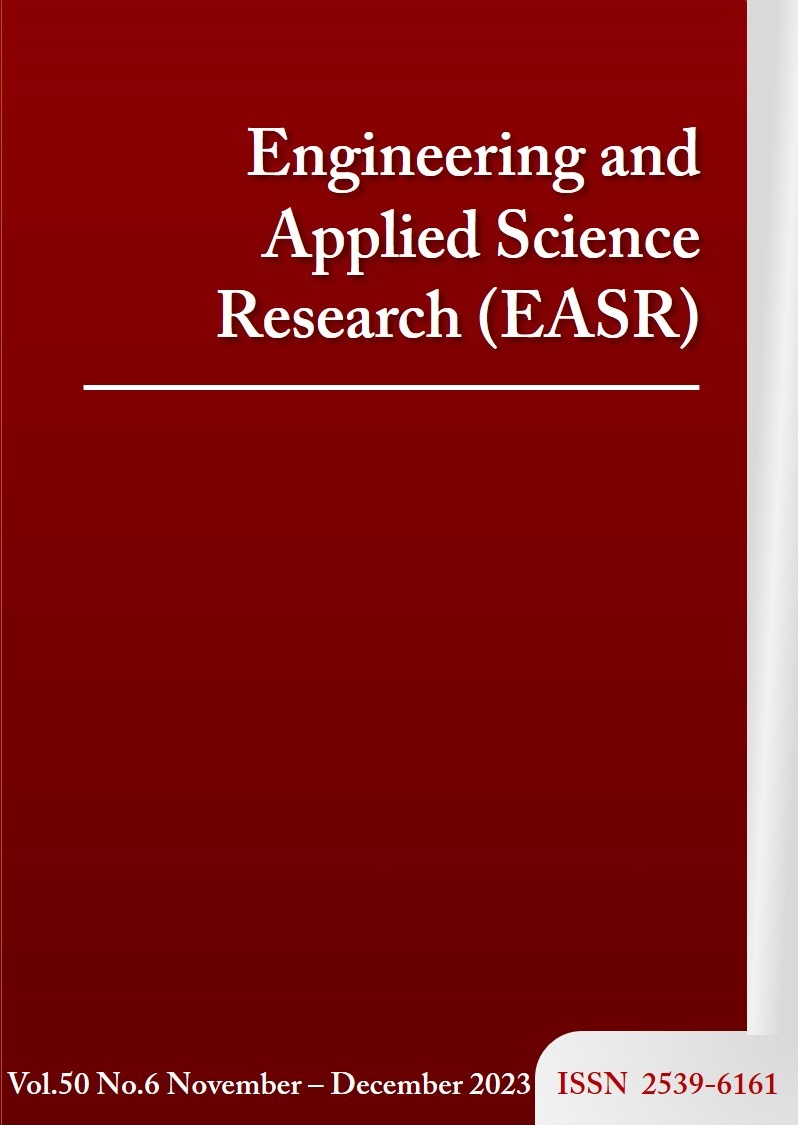Behavior and model of grain separation for a small axial flow maize shelling unit
Main Article Content
Abstract
Shelling and grain separation by a small axial flow maize sheller is influenced by the performance of both the maize shelling and cleaning units. For this study, the shelling and grain separation behavior were examined in a mini-maize grain separation unit. Concave rod clearance (CR) had the most impact on the effectiveness of grain separation. Concave rod clearances 10, 20 and 30 mm were selected as test parameters. Cumulative grain separation in a small axial flow maize shelling unit was analyzed in three zones, the feeding zone, the second and third zones, where the last two zones were separated zones. Test results indicated that when CR was increased, cumulative separation of grain, husks and cobs increased along the length of the shelling unit. These parameter relationships were represented using second-degree polynomial equations. An optimal shelling model for a small axial flow maize shelling unit was created. The function, S(l), represented cumulative grain separation as a function of separation length (l). The results from five shelling models indicated that predicted shelling parameters using Caspers’s model for both the feed rate and rotor peripheral speeds was the most satisfactory, with lowest root mean square error (RMSE) and highest coefficient of determination (R2).
Article Details

This work is licensed under a Creative Commons Attribution-NonCommercial-NoDerivatives 4.0 International License.
This work is licensed under a Creative Commons Attribution-NonCommercial-NoDerivatives 4.0 International License.
References
Ashofteh Beiragi M, Ebrahimi M, Mostafavi K, Golbashy M, Khavari Khorasani, S. A study of morphological basis of corn (Zea mays L.) yield under drought stress condition using correlation and path coefficient analysis. J Cereals Oilseeds. 2011;2(2):32-7.
Farjam A, Omid M, Akram A, Fazel Niari Z. A neural network based modeling and sensitivity analysis of energy inputs for predicting seed and grain corn yields. J Agr Sci Tech. 2014;16:767-78.
Oladejo JA, Ajetomobi JO, Fabiyi, YL. Transactions costs and agricultural household supply response of maize farmers in Oyo State of Nigeria. J Agric Soc Sci. 2011;7(2):69-74.
Chuan-Udom S. Operating factors of Thai threshers affecting corn shelling losses. Songklanakarin J Sci Technol. 2013;35(1):63-7.
Kunjara B, Wijarn C, Therdwongworakul A. Testing and evaluation of locally-made maize sheller. Journal of the National Research Council of Thailand. 1998;20:41-57. (In Thai)
Doungpueng K, Chuan-Udom S. Effects of guide vane inclination patterns on threshing losses and power requirement. Kasetsart J (Nat Sci). 2014;48:313-22.
Srison W, Chuan-Udom S, Saengprachatanarak K. Effects of operating factors for an axial-flow corn shelling unit on losses and power consumption. Agric Nat Resour. 2016;50(5):421-5.
Chansrakoo W, Chuan-Udom S. Factors of operation affecting performance of a short axial-flow soybean threshing unit. Eng J. 2018;22(4):109-20.
Saeng-ong P, Chuan-Udom S, Saengprachatanarak K. Effects of guide vane inclination in axial shelling unit on corn shelling performance. Kasetsart J(Nat Sci). 2015;49(5):761-71.
Srison W, Chuan-Udom S, Saengprachatanarak K. Design factors affecting losses and power consumption of an axial flow corn shelling unit. Songklanakarin J Sci Technol. 2016;38(5):591-8.
Muenkaew P, Duangkhamjan J, Chuan-Udom S. Factors affecting sunflower threshing performance of a small axial flow threshing unit. Eng Appl Sci Res. 2022;49(5):720-30.
Chuan-Udom S, Thongsawatwong P, Saengprachatanarug K, Eizo T. Peg-tooth spacing and guide vane inclination of a Thai combine harvester affecting harvesting losses. Eng Appl Sci Res. 2018;45(2):107-11.
Chuan-Udom S. Behavior of grain separation in Thai transverse axial threshing unit for Chainat 1 rice variety. Eng J. 2015;19(5):155-65.
Maertens K, De Baerdemaeker J. Flow rate based prediction of threshing process in combine harvesters. Appl Eng Agric. 2003;19(4):383-8.
Miu PI, Kutzbach HD. Simulation of threshing and separation processes in threshing units. Agrartechnische Forschung Sonnderheft. 2000;6:1-6.
Chuan-Udom S, Chinsuwan W. Effects of threshing unit feature on threshing unit losses for Thai axial flow rice combine harvesters. AMA-Agr Mech Asia Af. 2012;43:66-71.
Kutzbach HD. Simulation approaches of threshing and separating processes in combines. Tagung Landtechnik 2000: Conference Agricultural Engineering 2000; 2000 Oct 10-11; Germany.
Rusanov AJ. Calculation of the feed rates of combine harvesters. Mechanizacija i elektrifikacija socialisticeskogo sel’skogo chozjajstva. 1976;12:9-11. (In Russian)
Alferov SA, Braginec VS. Threshing and grain separation in threshing units as a uniform probability–conditioned process. Traktory i sel chozmasiny. 1972;42:23-6. (In Russian)
Caspers LD. Separation function as a contribution to the theory of rasp bars threshing units (Abscheidungsfunktion als Beitrag zur Theorie des Schlagleistendreschwerk) [dissertation]. Bundesforschungsanstalt für Landwirtschaft Braunschweig-Völkenrode; 1973.
Miu PI. Mathematical Modelling of Threshing Process in Cereal Combine Harvesters (Modelarea procesului de treier la combinele de recoltat cereal) [dissertation]. Bucharest: Politehnica University of Bucharest; 1995.
Butts CL, Sorensen RB, Nuti RC, Lamb MC, Faircloth WH. Performance of equipment for in-field shelling of peanut for biodiesel production. Trans ASABE. 2009;52(5):1461-70.
Zhao Z, Li Y, Chen J, Xu J. Grain separation loss monitoring system in combine harvester. Comput Electron Agric. 2011;76(2):183-8.
Zhong T, Yaoming L, Chenghong W. Experiments on variable-mass threshing of rice in the tangential-longitudinal-flow combine harvester. J Agr Sci Tech. 2013;15:1319-34.
Miu PI, Kutzbach HD. Modeling and simulation of grain threshing and separation in threshing unit-part I. Comput Electron Agric. 2008;60(1):96-104.



